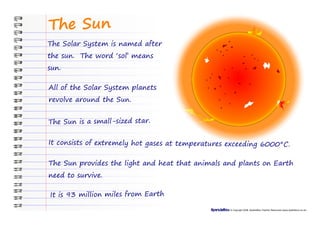More Related Content
Similar to The Solar System Scrapbook
Similar to The Solar System Scrapbook (20)
The Solar System Scrapbook
- 1. The Sun
The Solar System is named after
the sun. The word ‘sol’ means
sun.
All of the Solar System planets
revolve around the Sun.
The Sun is a small-sized star.
It consists of extremely hot gases at temperatures exceeding 6000°C.
The Sun provides the light and heat that animals and plants on Earth
need to survive.
It is 93 million miles from Earth
© Copyright 2008, SparkleBox Teacher Resources (www.sparklebox.co.uk)
- 2. Mercury
Mercury is the planet that’s closest to the Sun.
It is very hot and has no water or air and doesn’t have any moons.
It is covered with asteroid craters
on the surface.
Its year is only 88 days - this is how long
it takes to revolve around the sun.
Mercury has extreme temperatures. The
side facing the sun is searing hot and the
dark side is freezing cold.
© Copyright 2008, SparkleBox Teacher Resources (www.sparklebox.co.uk)
- 3. Venus
Venus is the second planet from It is covered with poisonous acid
the sun. clouds which trap in the Sun’s heat.
The surface is so hot that you could
melt metal there.
There is no oxygen or water.
It takes 255 days for Venus to revolve
around the sun.
Venus rotates in the opposite direction
to the other planets.
© Copyright 2008, SparkleBox Teacher Resources (www.sparklebox.co.uk)
- 4. Earth
Earth is the 3rd planet from the Sun.
Water is abundant on the surface.
It is the only known planet to have
plant life and animals on it.
It takes about 365 days to revolve around
the Sun - one Earth year.
It takes 24 hours for one full rotation on its axis - one Earth day.
Earth has one moon that revolves around it.
© Copyright 2008, SparkleBox Teacher Resources (www.sparklebox.co.uk)
- 5. Mars
Mars is often known as the ‘Red Planet’
because of it’s red rocky surface.
Mars’ surface is rocky and is covered
with volcanoes, craters, canyons,
mountains and red dust.
It has 2 small moons called Phobos and
Deimos.
It takes 687 Earth days to revolve around the Sun.
Mars has a very thin atmosphere of mainly carbon dioxide.
Severe dust storms can cover the whole planet for months at a time.
© Copyright 2008, SparkleBox Teacher Resources (www.sparklebox.co.uk)
- 6. Jupiter
Jupiter is the largest planet -
1000 Earths could fit inside it!
It is the 5th planet from the Sun.
Jupiter is made of gases that swirl
in storms that last for years.
It does not have a solid surface.
Its famous ‘red spot’ is 3 times the size of planet Earth.
It has faint rings of ice and dust that circle the planet, and 16 moons
revolve around it!
Jupiter takes 12 Earth years to revolve around the sun.
© Copyright 2008, SparkleBox Teacher Resources (www.sparklebox.co.uk)
- 7. Saturn
Saturn is the 6th planet from the Sun.
It is made of gases that are
lighter than water.
The planet has strong storms
with lightning and auroras.
Saturn is encircled by thousands
of rings that are made up of
ice, rock and dust.
Saturn has at least 31 moons but astronomers keep finding new ones!
Saturn takes 29.5 to revolve around the Sun.
© Copyright 2008, SparkleBox Teacher Resources (www.sparklebox.co.uk)
- 8. Uranus
Uranus is a gas planet .
The whole planet is covered with a thick, blue-green fog.
It is circled by rings and has grey-coloured moons which astronomers
think are made from graphite.
One year on Uranus is the same as 84 Earth years.
© Copyright 2008, SparkleBox Teacher Resources (www.sparklebox.co.uk)
- 9. Neptune
Neptune is the last gas-planet in the Solar System.
It is almost 3 billion miles away from the Sun and is one of the coldest
planets.
It takes 165 Earth years for it to
revolve around the Sun.
Its atmosphere is mostly hydrogen,
helium and methane gases.
Neptune is the 8th planet and
final planet in our Solar System.
© Copyright 2008, SparkleBox Teacher Resources (www.sparklebox.co.uk)
- 10. The Solar System © Copyright 2008, SparkleBox Teacher Resources (www.sparklebox.co.uk)
